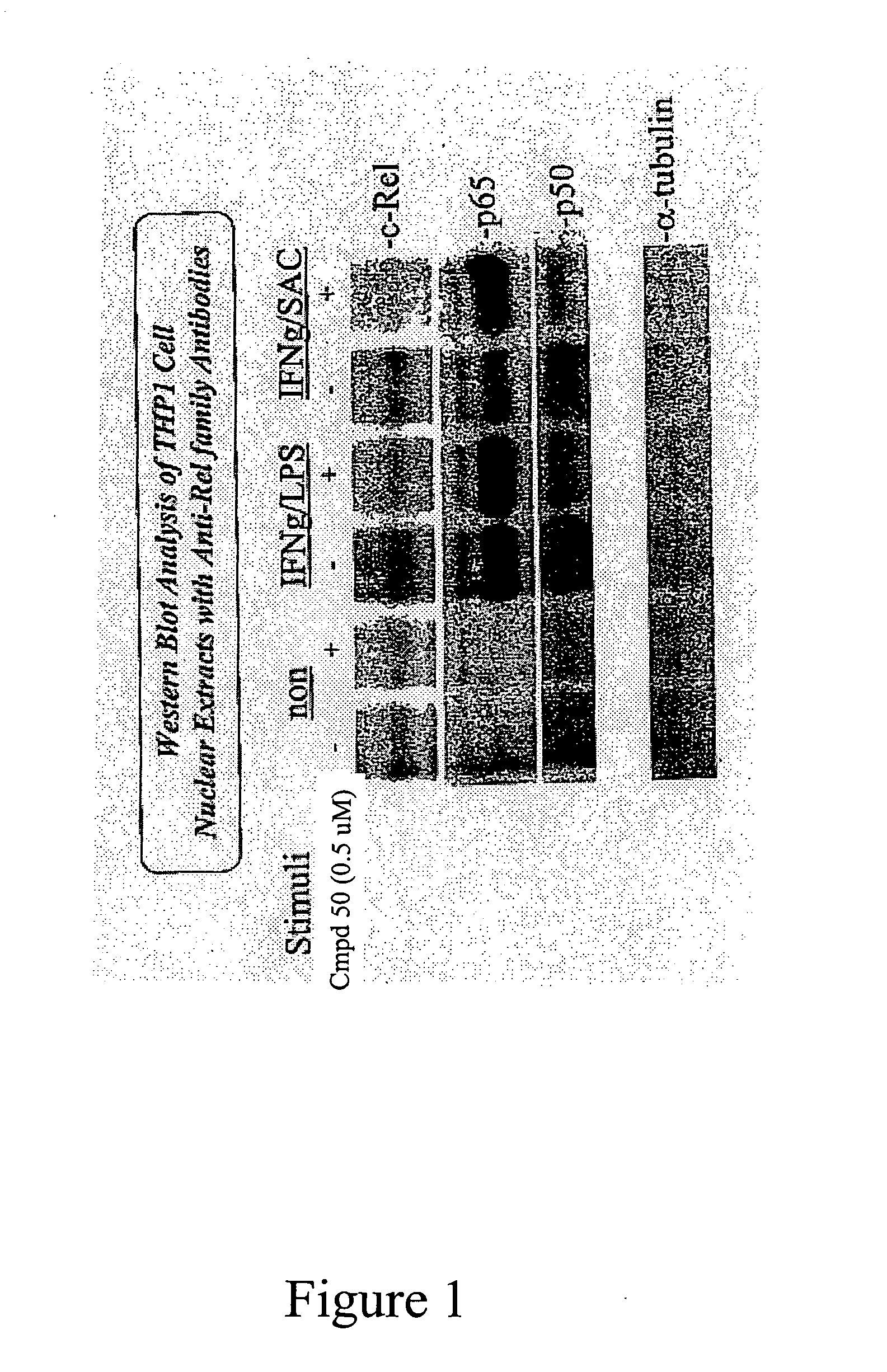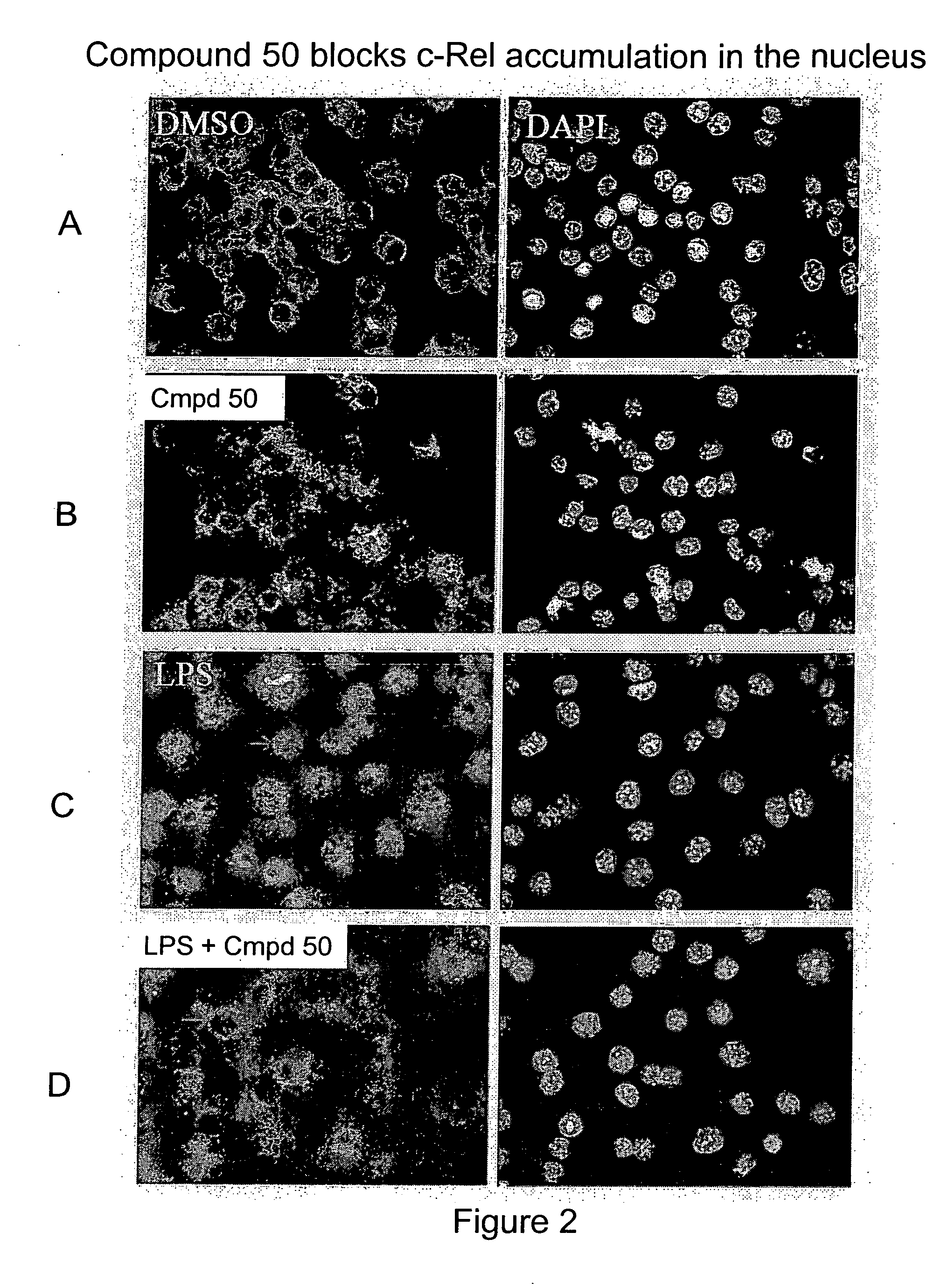Method for treating B cell regulated autoimmune disorders
- Summary
- Abstract
- Description
- Claims
- Application Information
AI Technical Summary
Problems solved by technology
Method used
Image
Examples
example 1
Effect of Compound 50 on c-Rel and ICSBP (measuring the level of both in the nucleus)
[0423] Of the transcription factors that have been analyzed, two factors, ICSBP and c-Rel, seem to be affected by Compound 4 / Compound 50 treatment. ICSBP binds indirectly to the Ets-2 site. The primary NF-κB trans-activator for IL-12 is the c-Rel / p50 heterodimer. Other dimers (p65 / p50 and p50 / p50) either lack activity or have inhibitory functions. Thus, c-Rel plays a role in IL-12 transcription as a result of both activation through NF-κB and its interaction with ICSBP. Both Western blot analysis and DNA binding studies showed a decrease in nuclear c-Rel levels following Compound 50 treatment. As seen in FIG. 1, a western blot assay of THP1 nuclear c-Rel, p50 and p65 proteins was carried out by the following method: 10% SDS polyacrylamide gels (Invitrogen) were transferred to a Pure nitrocellulose membrane (BioRed, Hercules, Calif.). The membranes were blocked with 5% milk in TBST buffer and then i...
example 2
Compound 50 Blocks accumulation of c-Rel, but not p65, in the nucleus of LPS stimulated cells.
[0426] We next examined whether compound 50 can block the accumulation of c-Rel in the nucleus of cells induced by LPS (FIG. 2). RAW264.7 cells cultured in DMEM with 10% BCS were split and seeded into 4-well chambered slides at 80,000 cells / well density. The cells were then treated with DMSO, Compound 50 (100 nM), LPS (Sigma, 5 μg / mL), LPS (5 μg / mL)+Compound 50 (100 nM) for 4 hours and fixed with 3% paraformaldehyde solution (1×PBS) after 1× quick rinse with 1×PBS. Fixed cells were permeablized with 0.2% TX100 and immunostained with anti-cRel antibody (SC70, Santa Cruz, 1:200 dilution) or anti-NF-κB p65 antibody (SC109, Santa Cruz, 1:100 dilution), and subsequently stained with Alexa Fluor 488 Goat-anti-Rabbit secondary antibody and DAPI (Molecular Probes, 1.1 μM). Images were obtained with CoolSNAP monochrome CCD camera on a Nikon inverted microscope TE300 using identical imaging paramete...
example 3
Effect of Compound 50 on IκB
[0427] IκB degradation is one of the steps in the signaling pathway of NF-κB dependent genes. The activity of Compound 50 in inducible degradation of IκBα and IκBβ was investigated in THP-1 cells using Western blot and FACS analysis. The amount of IκBα and IκBβ in the cytoplasm of THP-1 and RAW267.4 cells was significantly reduced at 30 min in response to induction by IFN-γ / LPS or IFN-γ / SAC. However, there was no significant difference observed between the samples which were treated with or without Compound 50 (500 nM) at 30 min and 2 hrs. Similar results were observed from the Compound 50 pre-treatment samples in which Compound 50 was added 30 min before stimulation. These results show that Compound 50 does not induce the degradation of IκBα and IκBβ to allow free NF-κB to translocate into the nucleus where it can act as a transcription factor.
PUM
| Property | Measurement | Unit |
|---|---|---|
| temperature | aaaaa | aaaaa |
| concentrations | aaaaa | aaaaa |
| concentrations | aaaaa | aaaaa |
Abstract
Description
Claims
Application Information
 Login to View More
Login to View More - R&D
- Intellectual Property
- Life Sciences
- Materials
- Tech Scout
- Unparalleled Data Quality
- Higher Quality Content
- 60% Fewer Hallucinations
Browse by: Latest US Patents, China's latest patents, Technical Efficacy Thesaurus, Application Domain, Technology Topic, Popular Technical Reports.
© 2025 PatSnap. All rights reserved.Legal|Privacy policy|Modern Slavery Act Transparency Statement|Sitemap|About US| Contact US: help@patsnap.com



